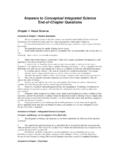Transcription of Answers to Study Questions - Jones & Bartlett …
1 Jones and Bartlett Publishers, LLC. NOT FOR SALE OR DISTRIBUTION. Answers to Study Questions Chapter 1 5. List and define the four main Dietary Reference Intake categories. 1. What are the main factors that influence our food choices? The Estimated Average Requirement (EAR) is the nutrient Sensory, cognitive, and cultural intake level that is estimated to meet the needs of 50 percent of the individuals in a life-stage and gender group. 3. List the 6 classes of nutrients. The Recommended Dietary Allowance (RDA) is the daily intake Carbohydrate, protein, fat, vitamins, minerals, and water level that meets the needs of most (97 to 98 percent) people in 5. What determines whether a mineral is a macromineral or a a life-stage and gender group. micro-(trace) mineral? An Adequate Intake (AI) level is set when an RDA has yet to be Macrominerals are found in and used by the body in the largest established due to lack of knowledge and the need for more amounts. scientific research. Microminerals are found in and used by the body in smaller The Tolerable Upper Intake Level (UL) is the maximum daily amounts.
2 Intake level that is unlikely to pose health risks to almost all of the individuals in a life-stage and gender category. 7. What is an epidemiological Study ? An epidemiological Study observes and compares how disease 7. The standard Nutrition Facts panel shows information on which rates vary among different population groups and identifies nutrients? conditions related to diseases or conditions within the popula- Calories tions. This enables researchers to identify associations between Calories from fat factors within the population and the particular disease being Total fat studied. Saturated fat 9. What is a placebo? Trans fat A placebo is an imitation treatment that looks the same as the Cholesterol experimental treatment (such as a sugar pill) but has no effect. Total carbohydrates The placebo is important for reducing bias because subjects Dietary fiber do not know if they are receiving the intervention and are less Sugars inclined to alter their responses or reported symptoms based on Protein what they think should happen.
3 Sodium Calcium, iron, vitamins A and C (all as a % Daily Value). Chapter 2 9. Define the three types of claims that may be found on food labels. Nutrient content claims describe the level of a nutrient or 1. Define undernutrition and overnutrition. dietary substance in the product using terms such as good Undernutrition is poor health resulting from the depletion of source, high, or free. nutrients due to inadequate nutrient intake over time. It is most A health claim is any statement that associates a food or a sub- often associated with poverty, alcoholism, and some types of stance in a food with a disease or health-related condition. eating disorders. A structure/function claim describes a benefit related to a The most common type of overnutrition in the United States is nutrient-deficiency disease or describes the role of a nutrient or due to the regular consumption of excess calories, fats, satu- dietary ingredient intended to affect a structure or function in rated fats, and cholesterol.
4 Humans; for example, calcium helps build strong bones. 3. What are the recommended amounts for each of the food groups of MyPyramid for a 2,000-calorie diet? Grains: 6 ounce equivalents; half should be whole grains Chapter 3. Vegetable group: 21 2 cups 1. The contents of which organ has the lowest pH? Which organ Fruits: 2 cups produces an alkaline or basic solution to buffer this low pH? Milk: 3 cups The stomach's contents have the lowest pH due to the Meat and beans: 51 2 ounce equivalents stomach's production of hydrochloric acid. 2 3/23/10 9:57:15 AM. Jones and Bartlett Publishers, LLC. NOT FOR SALE OR DISTRIBUTION. Answers to Study Questions SA-1. The pancreas secretes fluid that contains mostly water, bicar- bonate, and digestive enzymes. In the small intestine, this basic Chapter 5. solution helps neutralize the acidic chyme entering from the 1. Explain how it is possible for oils to contain a mixture of polyun- stomach. saturated, monounsaturated, and saturated fats. 3. Where in the GI tract does the majority of nutrient digestion and Oils are triglycerides.
5 Triglycerides contain a glycerol molecule absorption take place? and three fatty acids. These fatty acids can vary in three main Small intestine ways: length, saturation, and omega number. An oil such as corn oil has more polyunsaturated fatty acids attached to 5. Name three assisting organs that are not part of the GI tract glycerol than it does monounsaturated or saturated fatty acids. but are needed for proper digestion. What are their roles in Therefore, corn oil is known as a mostly polyunsaturated fat, digestion? but like all oils, it contains a mixture of fatty acids. Any three of the following: The salivary glands produce saliva that moistens food, lubri- 3. What is the most common form of lipid found in food? cating it for easy swallowing. Saliva contains enzymes that Triglycerides begin the process of chemical digestion. 5. List the many functions of triglycerides. The pancreas secretes digestive enzymes that help digest Provide energy (9 kilocalories per gram). nutrients.
6 Provide a concentrated source of stored calories (triglycer- The gallbladder stores and concentrates bile from the liver. ides in fat cells). The liver produces and secretes bile, which emulsifies fats in Carry flavor in foods the small intestine, thus aiding fat digestion. Pad and protect vital organs 7. What is gastroesophageal reflux disease? Provide thermal insulation (subcutaneous fat). Gastroesophageal reflux disease (GERD) occurs when the lower esophageal sphincter (LES) is weak or relaxes inappropriately, 7. What foods contain cholesterol? allowing the stomach's contents to flow back up into the esoph- Any foods that contain ingredients derived from an animal will agus. The acidic stomach contents irritate the gastroesophageal contain cholesterol. lining, causing severe pain. Chapter 6. Chapter 4. 1. List the functions of body proteins. 1. Describe the difference between starch and fiber. Comprise muscles and organs Both starch and fiber are long chains of glucose molecules, but Work as hormones, enzymes, and antibodies we are unable to digest the bonds between the glucose units in Help to regulate fluid and electrolyte balance fiber.
7 Therefore, fiber moves through the small intestine undi- gested, while starch is broken down into glucose and absorbed. Help to regulate acid base balance Used as transporter molecules 3. What are the consequences of eating too few carbohydrates? Carbohydrates provide energy (fuel) to the cells of the body. 3. Among the nutrient molecules, which element is unique to Consuming too few carbohydrates can result in the breakdown protein, and how does it fit into the basic structure of an amino of body proteins that supply glucose and energy. Inadequate acid? carbohydrate intake prevents fats from breaking down normally, Nitrogen is part of the chemical structure of amino acids (pro- and this results in ketosis. teins), but not of carbohydrates and lipids. Nitrogen is part of the amino group, NH2. 5. Which foods contain carbohydrates? Grains, fruits, and vegetables are the most carbohydrate-dense 5. What are complementary proteins? List three examples of food foods. Many dairy foods also contribute quite a bit of carbo- combinations that contain complementary proteins.
8 Hydrate. Legumes often are rich in both carbohydrates and Two proteins that, when combined, contain all of the indis- protein. Sweets, of course, contain carbohydrates in the form of pensable amino acids in adequate amounts to support health. sugars. Examples include rice and beans, peanut butter on bread, corn 7. Describe the structure of a monosaccharide, disaccharide, and bread, and chili (beans). polysaccharide. 7. How is protein related to immune function? A monosaccharide is a single sugar ( , glucose, fructose, and Protein is used to make antibodies, which help fight infec- galactose). A disaccharide is a molecule of two single sugars tion. Without adequate dietary protein, synthesis of antibod- ( , maltose, sucrose, and lactose). A polysaccharide is a long ies is impaired, and a person becomes more susceptible to chain of sugar units ( , starch and fiber). infection. 1 3/23/10 9:57:18 AM. Jones and Bartlett Publishers, LLC. NOT FOR SALE OR DISTRIBUTION. SA-2 Answers to Study Questions 9.
9 List the potential health benefits of a vegetarian diet. 3. Where does alcohol metabolism take place? Reduced blood cholesterol levels The liver is the chief organ for alcohol metabolism. Reduced risk of some cancers 5. What causes fatty liver in an alcoholic? Improved body weight In alcohol metabolism, NAD is converted to NADH. Excess Reduced blood pressure NADH blocks the entry of acetyl CoA into the citric acid cycle. The acetyl CoA is diverted and used to synthesize fatty acids. Chapter 7 7. Among health authorities, what is the consensus about drinking alcohol? 1. What is the universal energy currency ? Where is most of it Most health officials do not promote the consumption of produced? alcohol; however, for people who do consume alcohol, they sug- ATP is the energy form usable by cells, so it is called the univer- gest moderation (no more than 2 drinks for males, 1 drink for sal energy currency. Most ATP is produced inside mitochondria, females, per day). so often they are called the powerhouses of the cell.
10 9. Why do health care professionals advise pregnant women not to 3. In the catabolic pathways, what two molecules are major elec- drink alcohol? tron acceptors? After they accept electrons, what electron carri- Alcohol can cause fetal alcohol syndrome (FAS). A safe lower ers do they become? What is the primary function of the electron limit for alcohol consumption during pregnancy is not currently carriers? known. NAD+ and FAD+ are the electron acceptors in the breakdown pathways. NADH and FADH2 are the electron carriers. They carry these Chapter 9. high-energy electrons to the electron transport chain, where the 1. Explain the concept of energy balance. electrons power the production of ATP. Energy balance is the relationship between your energy intake 5. What two carbon molecules does beta-oxidation form as it and energy output. You are in energy equilibrium when your clips the links of a fatty acid chain? What other molecules energy or caloric intake is equal to the amount of energy or important to the production of ATP does beta-oxidation produce?
















